The Impact of Temperature on the Performance and Reliability of Li/SOCl2 Batteries
Abstract
:1. Introduction
2. Battery Test Plan
2.1. Battery Samples
2.2. High-Temperature Battery Discharge Test
2.3. Battery Load Capacity Test
2.4. Battery EIS Testing
3. Statistical Analysis of Battery Life at Different Temperatures
3.1. Battery Discharge Test Data
3.2. Battery Life Data
3.3. Inference on Battery Life Statistics
3.4. Influence of Temperature on Battery Life
4. Impact of Temperature on Battery Voltage Output Characteristics
- (1)
- Effect of temperature on the battery’s voltage output capability
- (2)
- Effect of current on the battery’s voltage output capability
- (3)
- Effect of degradation level on the battery’s voltage output capability
- (4)
- Functional relationship between battery’s voltage output capability, temperature, current, and aging time
5. Effect of Temperature on the Failure Mechanism of Li/SOCl2 Batteries
5.1. Analysis of Li/SOCl2 Battery Impedance Based on EIS
5.2. Impact of Temperature on Voltage Hysteresis in Batteries
6. Conclusions
Author Contributions
Funding
Data Availability Statement
Conflicts of Interest
References
- Dai, Y.J.; Jing, Z.; Sun, Y.Q. Reliability-centered prediction methods of clock battery low-output-voltage event for smart electricity meters. Microelectron. Reliab. 2022, 138, 114631. [Google Scholar] [CrossRef]
- Sun, X.; Zhang, Y.; Zhang, Y.; Wang, L.; Wang, K. Summary of health-state estimation of lithium-ion batteries based on electrochemical impedance spectroscopy. Energies 2023, 16, 5682. [Google Scholar] [CrossRef]
- Fan, M.S.; Geng, M.M.; Yang, K.; Zhang, M.J.; Liu, H. State of Health Estimation of Lithium-Ion Battery Based on Electrochemical Impedance Spectroscopy. Energies 2023, 16, 3393. [Google Scholar] [CrossRef]
- Song, H.Y.; Jung, M.H.; Jeong, S.K. Electrochemical properties of acetylene black/multi-walled carbon nanotube cathodes for lithium thionyl chloride batteries at high discharge currents. J. Electrochem. Sci. Technol. 2020, 11, 430–436. [Google Scholar] [CrossRef]
- Lee, S.B.; Pyun, S.I.; Lee, E.J. Effect of the compactness of the lithium chloride layer formed on the carbon cathode on the electrochemical reduction of SOCl2 electrolyte in Li–SOCl2 batteries. Electrochim. Acta 2001, 47, 855–864. [Google Scholar] [CrossRef]
- Cheng, S.J.; Li, B.; Yuan, Z.Z.; Zhang, F.Y.; Liu, J.C. Development of a lifetime prediction model for lithium thionyl chloride batteries based on an accelerated degradation test. Microelectron. Reliab. 2016, 65, 274–279. [Google Scholar] [CrossRef]
- Cheng, S.J.; Yuan, Z.Z.; Ye, X.P.; Zhang, F.Y.; Liu, J.C. Empirical prediction model for Li/SOCl2 cells based on the accelerated degradation test. Microelectron. Reliab. 2015, 55, 101–106. [Google Scholar] [CrossRef]
- Ye, X.R.; Sun, Q.S.; Li, H.X.; Li, W.W.; Liu, L.; Zhai, G.F. Reliability Evaluation of Li/SOCl2 Battery for Smart Electricity Meter Based on Remaining Capacity. Conf. Ser. Mater. Sci. Eng. 2021, 1043, 032016. [Google Scholar] [CrossRef]
- Chen, Y.; Chen, Z.Y.; Zhu, M.M.; Liao, Y.H.; Luo, F.; Li, X.R. Smart Electricity Meter Prognostics Based on Lithium Battery RUL Prediction. Distrib. Gener. Altern. Energy J. 2021, 37, 449–464. [Google Scholar] [CrossRef]
- Arora, P.; Ralph, E.; Doyle, W.M. Capacity fade mechanisms and side reactions in lithium-ion batteries. J. Electrochem. Soc. 1998, 145, 3647–3667. [Google Scholar] [CrossRef]
- Han, X.B.; Ouyang, M.G.; Lu, L.G.; Li, J.Q.; Zheng, Y.J.; Li, Z. A comparative study of commercial lithium ion battery cycle life in electrical vehicle: Aging mechanism identification. J. Power Sources 2014, 251, 38–54. [Google Scholar] [CrossRef]
- Ouyang, M.G.; Feng, X.N.; Han, X.B.; Lu, L.U.; Li, Z.; He, X.M. A dynamic capacity degradation model and its applications considering varying load for a large format Li-ion battery. Appl. Energy 2016, 165, 48–59. [Google Scholar] [CrossRef]
- Aubay, M.; Lojou, E. Film Formation on Lithium Electrode in LiAlCl4/SO2Cl2 and LiAlCl4: 3SO2 Based Electrolytes. J. Electrochem. Soc. 1994, 141, 865. [Google Scholar] [CrossRef]
- Li, S.; Dai, H.L.; Li, Y.H.; Lai, C.; Wang, J.L.; Huo, F.W.; Wang, C. Designing Li-protective layer via SOCl2 additive for stabilizing lithium-sulfur battery. Energy Storage Mater. 2019, 18, 222–228. [Google Scholar] [CrossRef]
- Ziesche, R.F.; Robinson, J.B.; Kok, M.D.R.; Markötter, H.; Kockelmann, W.; Kardjilov, N.; Manke, I.; Brett, D.J.L.; Shearing, P.R. Editors’ choice—4D neutron and X-ray tomography studies of high energy density primary batteries: Part I. Dynamic studies of LiSOCl2 during discharge. J. Electrochem. Soc. 2020, 167, 130545. [Google Scholar] [CrossRef]
- Carmier, D.; Vix-Guterl, C.; Lahaye, J. Porosity of the cathode during the discharge of SOCl2/Li batteries: I. Industrial cathodes. Carbon 2001, 39, 2181–2186. [Google Scholar] [CrossRef]
- Carmier, D.; Vix-Guterl, C.; Lahaye, J. Porosity of the cathode during the discharge of SOCl2/Li batteries: II. Model cathodes. Carbon 2001, 39, 2187–2193. [Google Scholar] [CrossRef]
- Jian, T.; Shenzhong, L. Failure process of Li/SOCl2 cells at 200 °C. J. Power Sources 1994, 52, 119–121. [Google Scholar] [CrossRef]
- Chen, L.T.; Yang, X.Y.; Wang, X.Q.; Hu, G.F.; Zhang, R.L.; Wang, N.S.; Zhao, J.S. High-efficiency electrocatalyst phthalocyanine in Li/SOCl2 batteries: From experimental to theoretical investigation. J. Electrochem. Soc. 2021, 168, 120505. [Google Scholar] [CrossRef]
- Chen, G.D.; Li, W.D.; Du, X.F.; Wang, C.; Qu, X.L.; Gao, X.Y.; Dong, S.M.; Cui, G.L.; Chen, L.Q. Transforming a Primary Li/SOCl2 Battery into a High-Power Rechargeable System via Molecular Catalysis. J. Am. Chem. Soc. 2023, 145, 22158–22167. [Google Scholar] [CrossRef]
- Chenebault, P.; Vallin, D.; Thevenin, J.; Wiart, R. Impedance analysis of the lithium discharge in Li/SOCl2 cells: Synergetic effect of SO2 and LiAl(SO3Cl)4. J. Appl. Electrochem. 1989, 19, 413–420. [Google Scholar] [CrossRef]
- Ko, Y.O.; Lee, C.T. Effects of the structural characteristics of carbon cathode on the initial voltage delay in Li/SOCl2 battery. J. Ind. Eng. Chem. 2012, 18, 726–730. [Google Scholar] [CrossRef]
- Zabara, M.A.; Uzundal, C.B.; Ulgut, B. Linear and nonlinear electrochemical impedance spectroscopy studies of Li/SOCl2 batteries. J. Electrochem. Soc. 2019, 166, A811. [Google Scholar] [CrossRef]
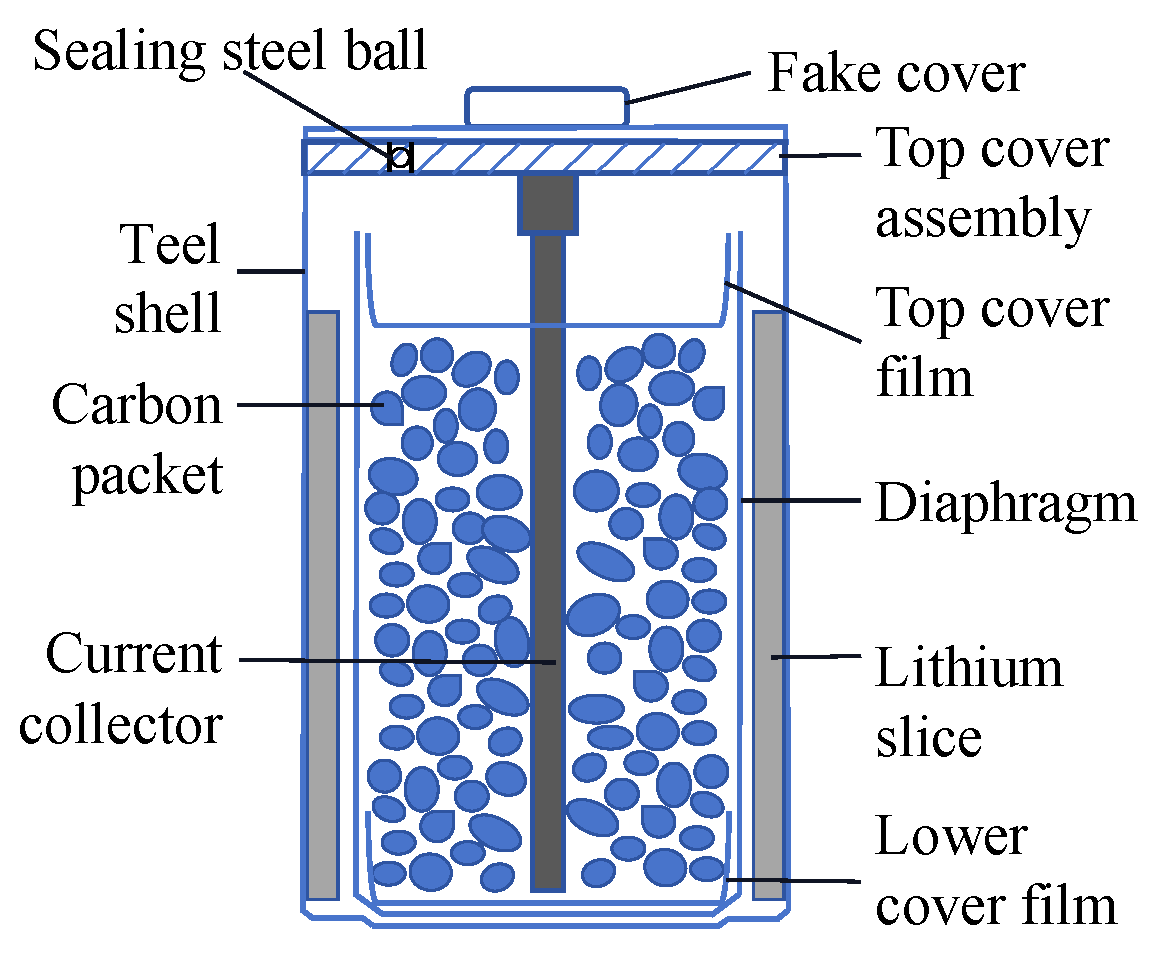

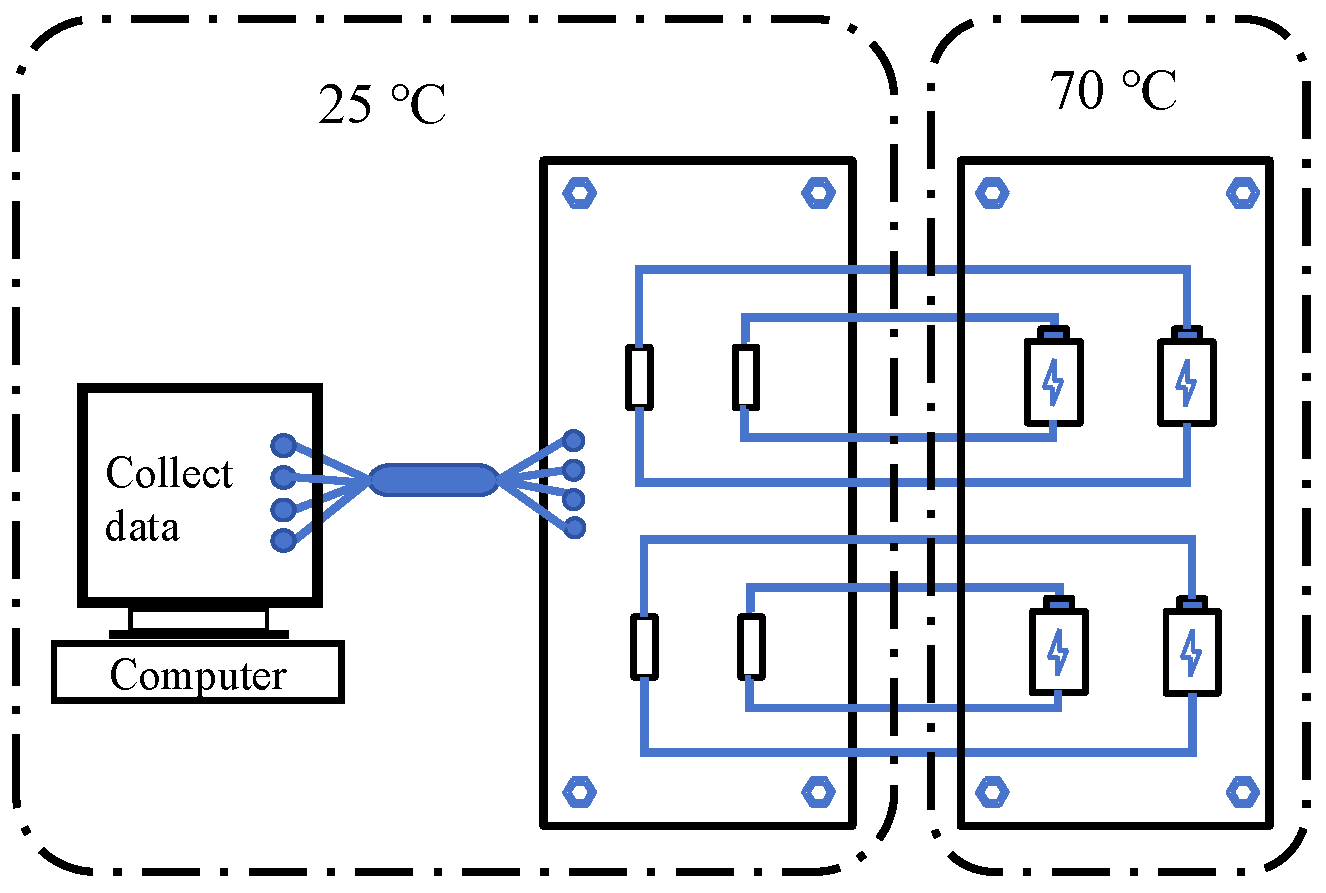

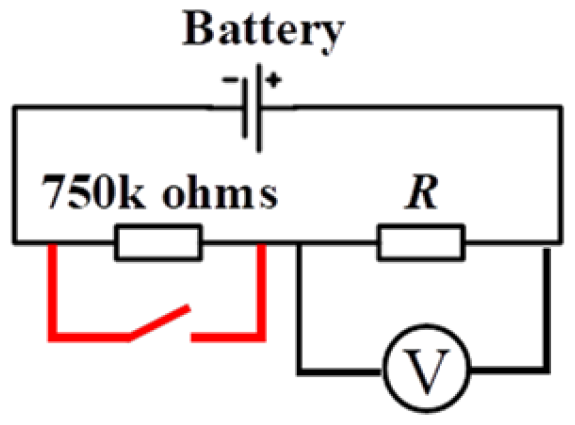
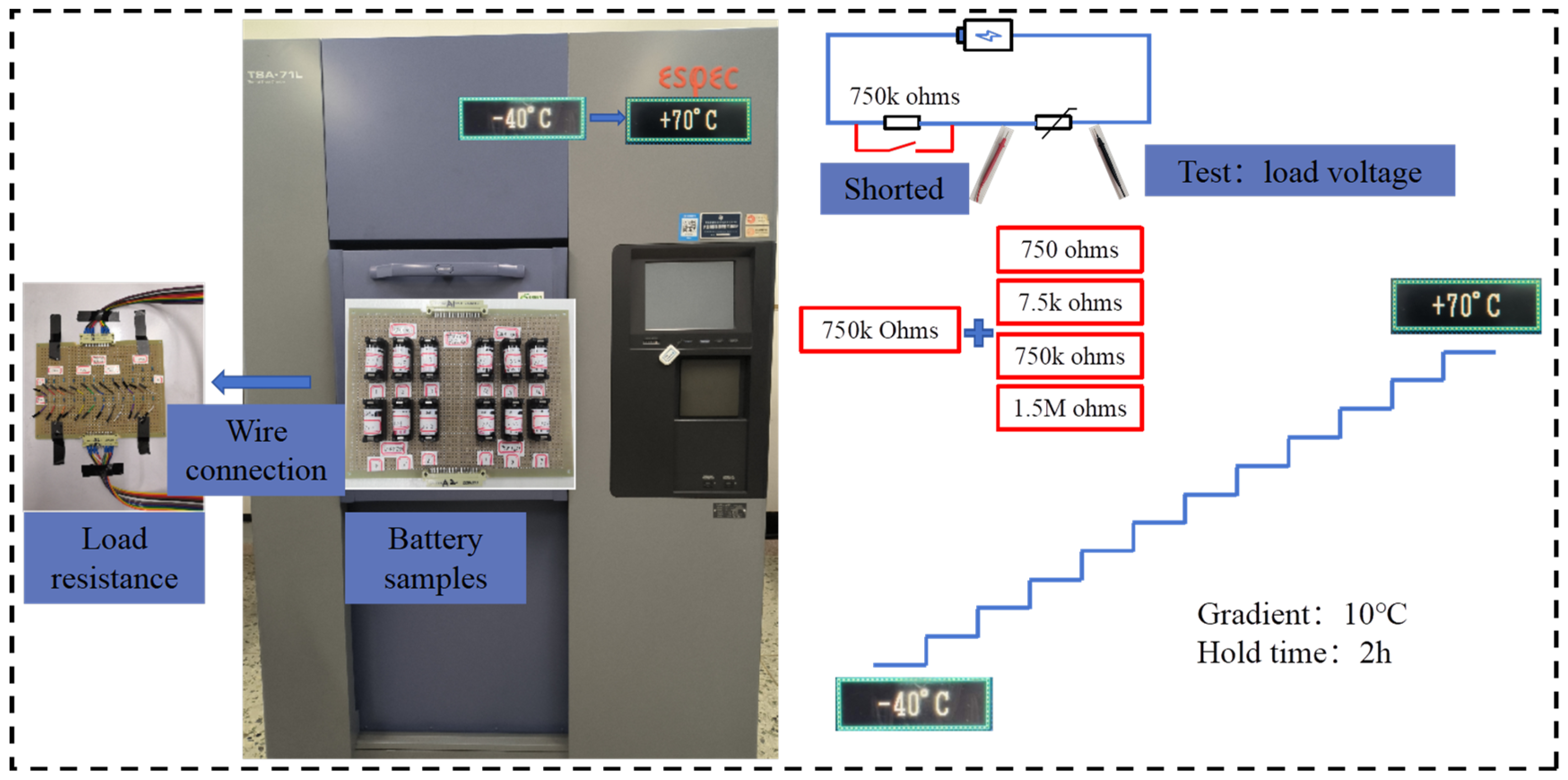
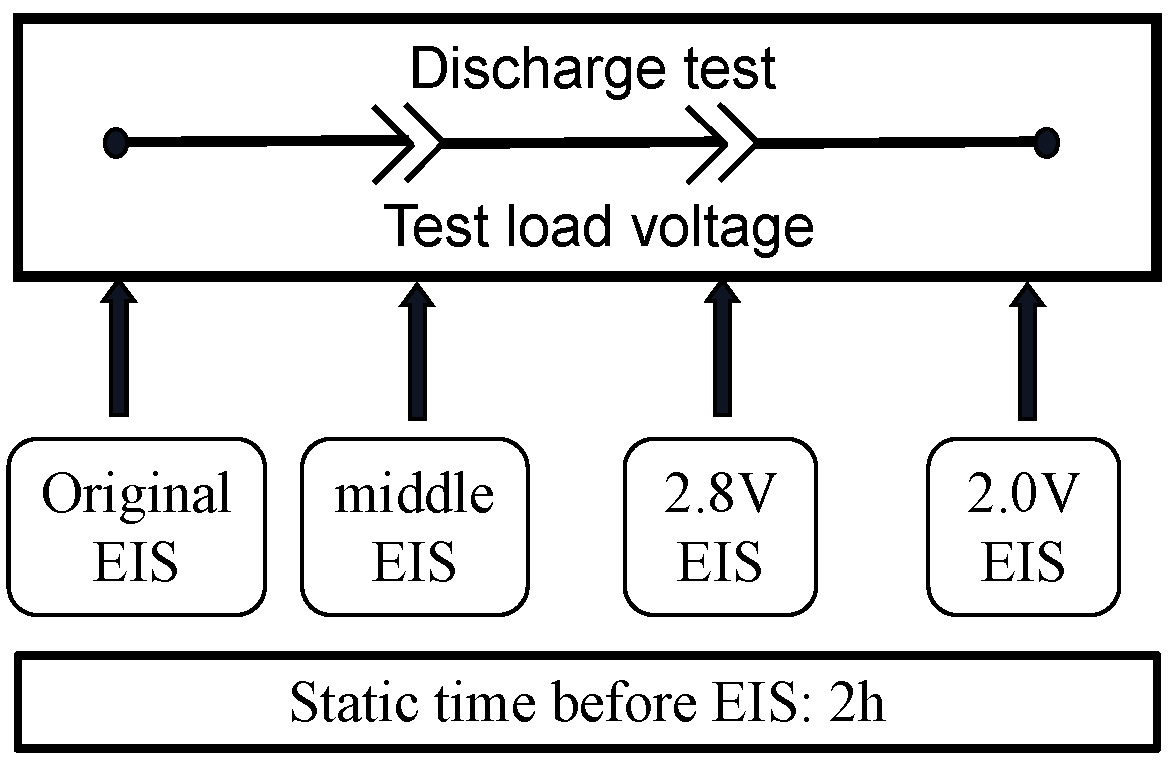

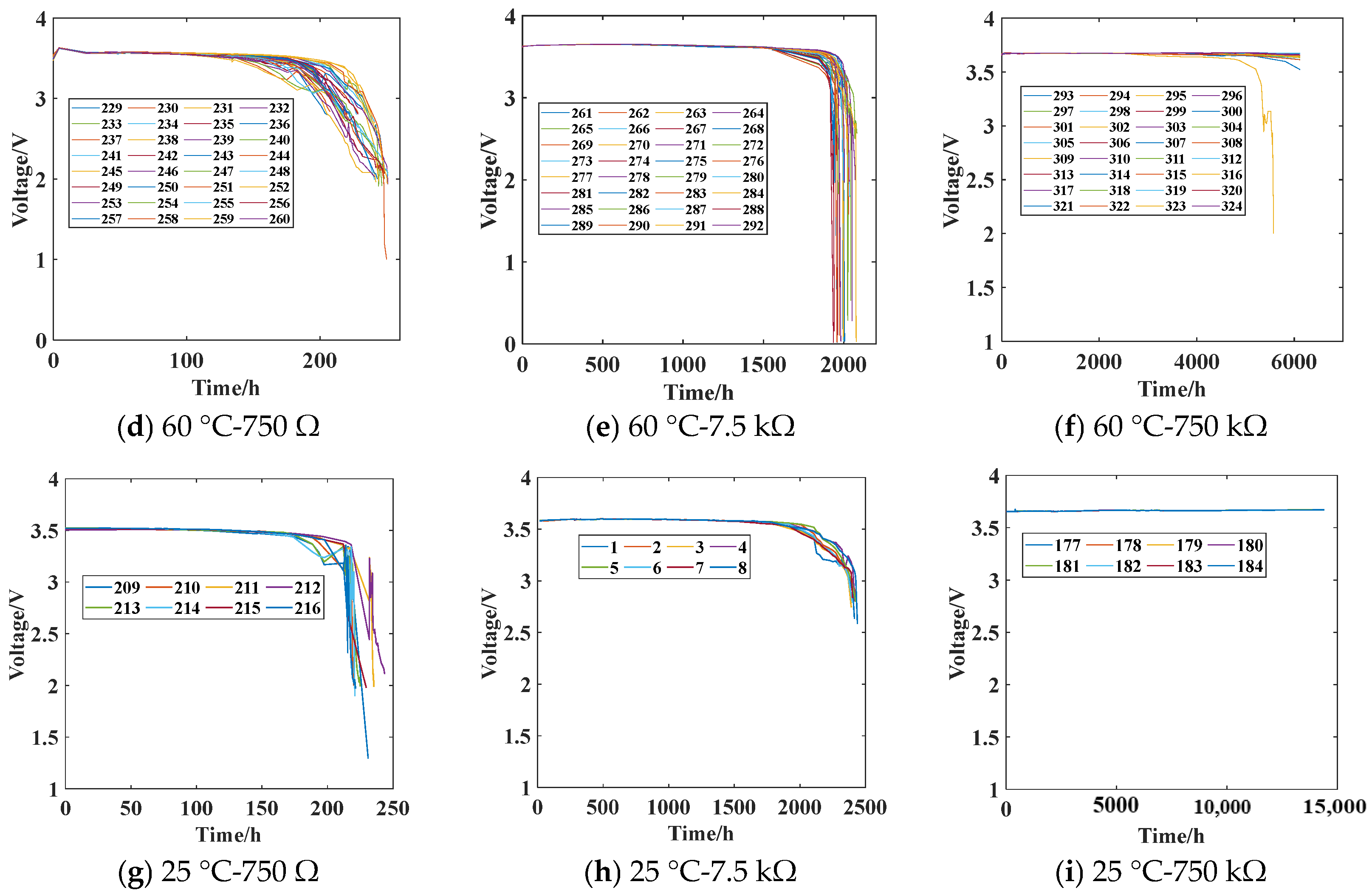
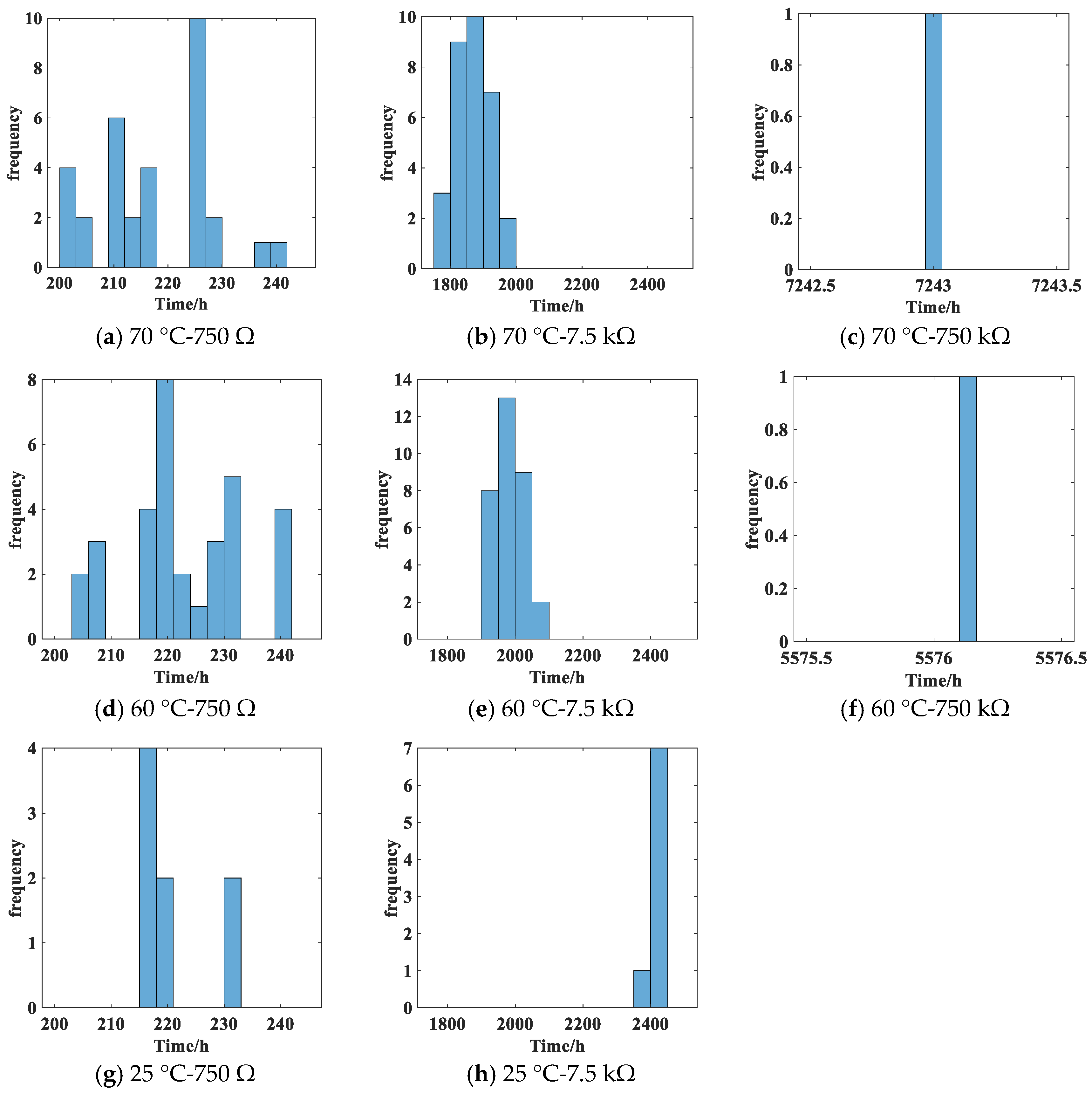
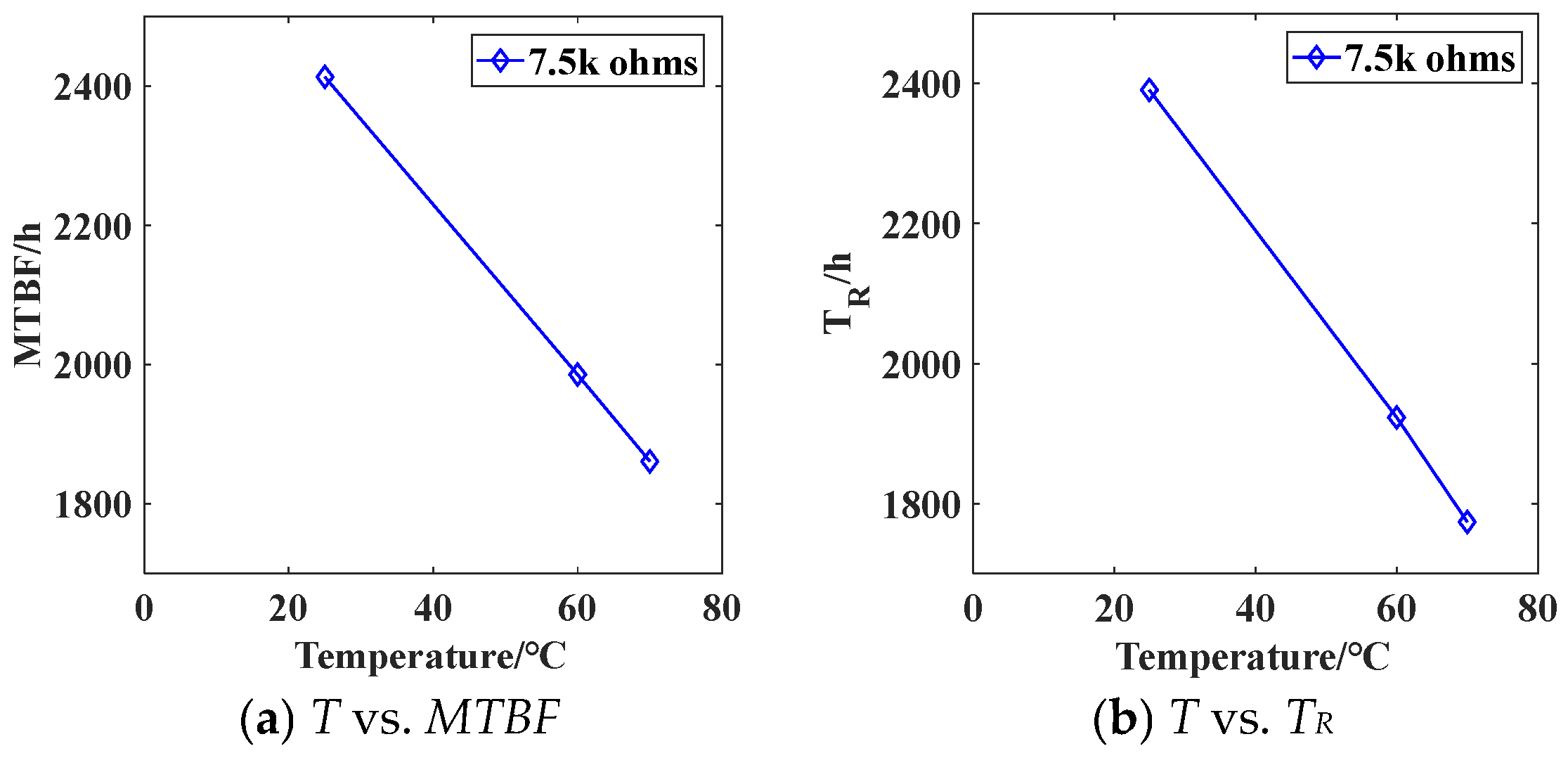

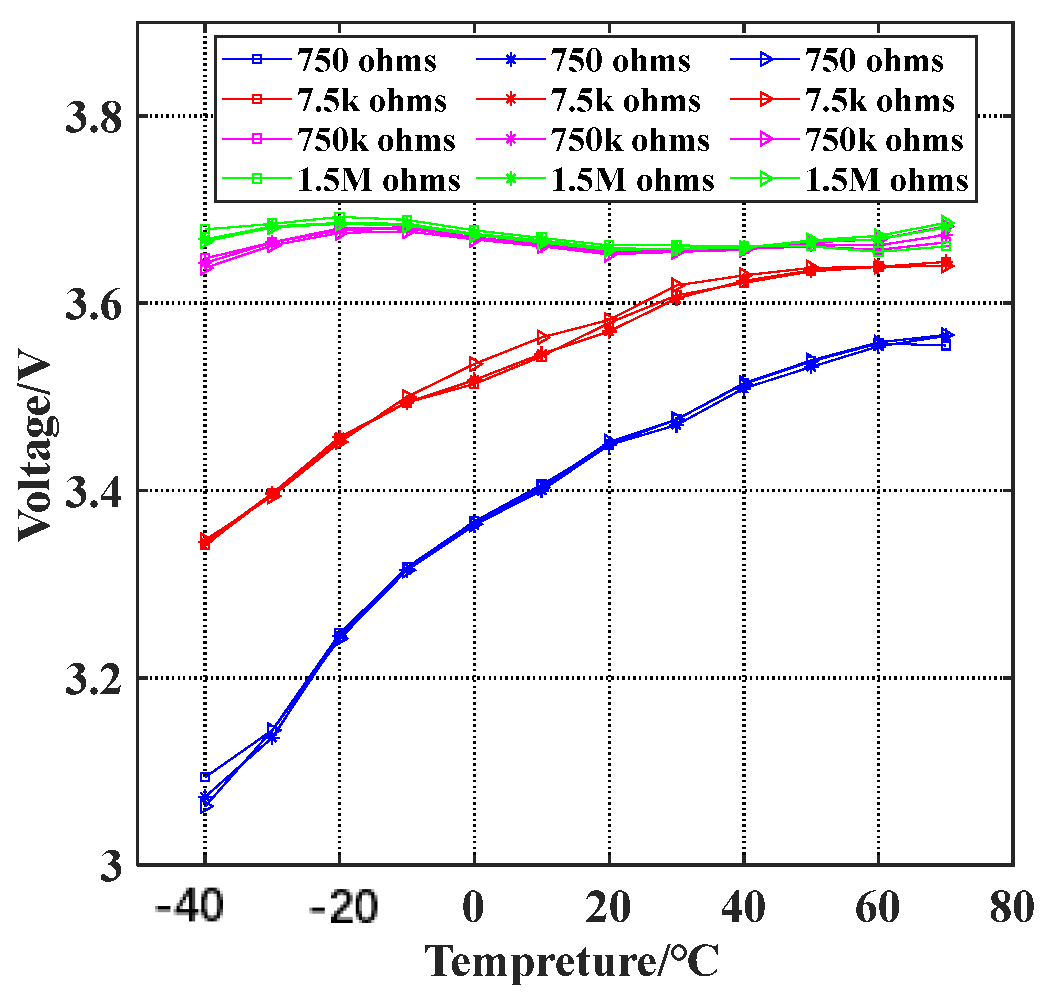


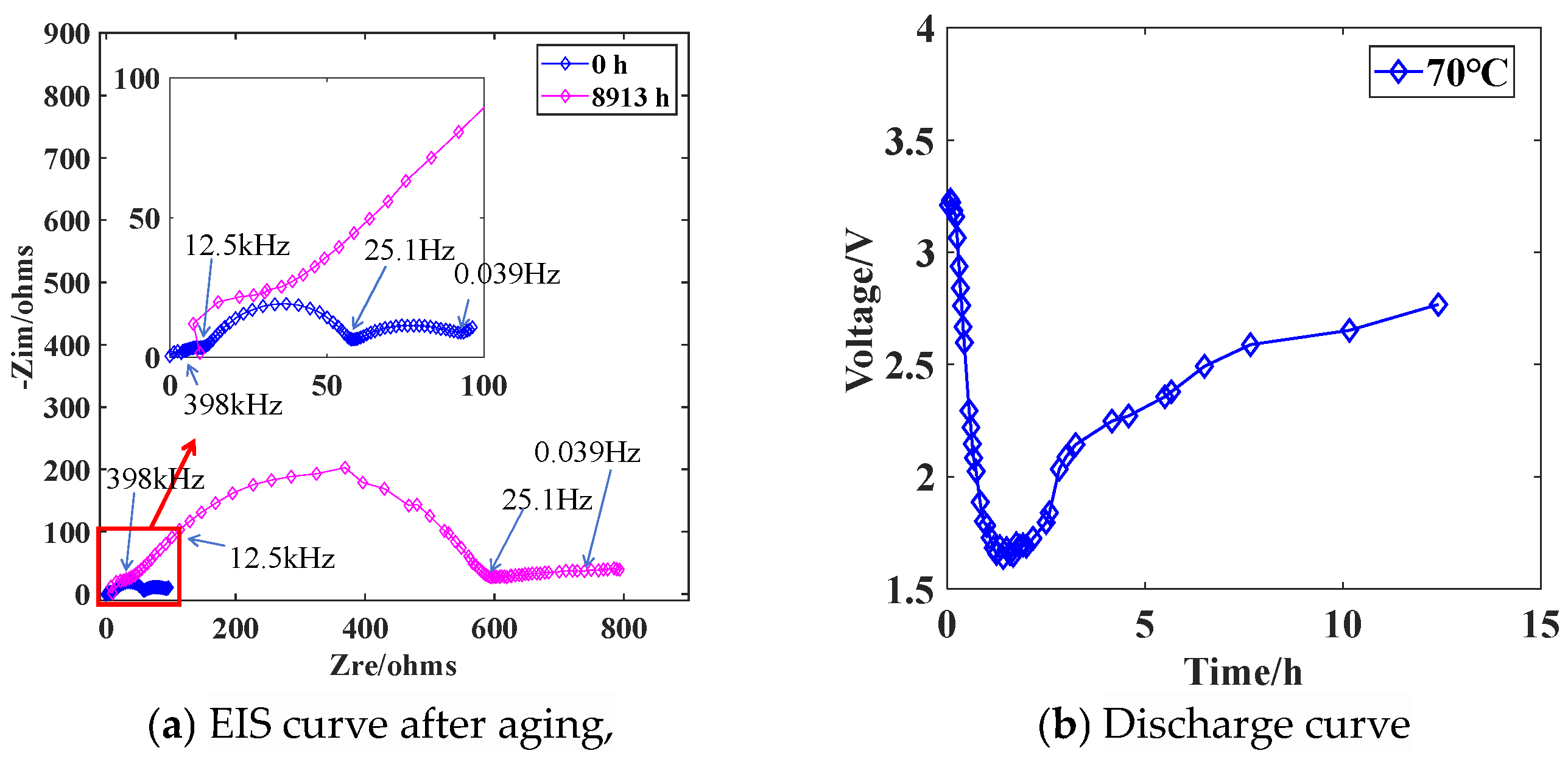
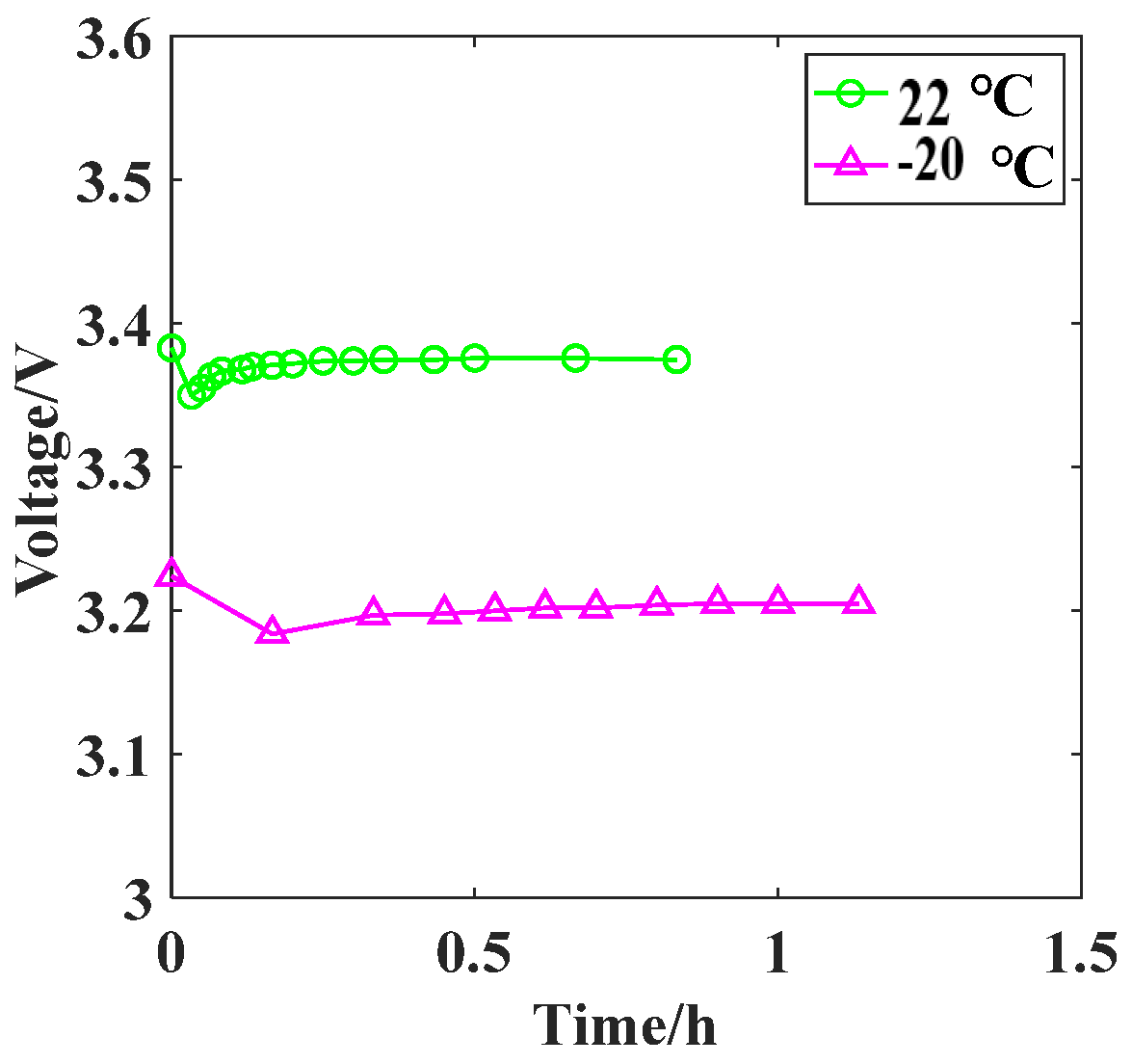
| Temperature/Load | 750 Ω | 7.5 kΩ | 750 kΩ |
|---|---|---|---|
| 70 °C | 32 batteries | 32 batteries | 32 batteries |
| 60 °C | 32 batteries | 32 batteries | 32 batteries |
| 25 °C | 8 batteries | 8 batteries | 8 batteries |
| Battery Samples | Aging Time | R = 750 Ω | R = 7.5 kΩ | R = 750 kΩ | R = 1.5 MΩ |
|---|---|---|---|---|---|
| New battery | 10 months, room temperature | 3 batteries | 3 batteries | 3 batteries | 3 batteries |
| 70 °C-750 kΩ | 1296 h | 3 batteries | 3 batteries | 3 batteries | 3 batteries |
| 5244 h | |||||
| 7294.5 h |
| Temperature | Point Estimates | 750 Ω | 7.5 kΩ |
|---|---|---|---|
| 70 °C | MTBF | 216.79 | 1860.74 |
| 199.97 | 1773.81 | ||
| 60 °C | MTBF | 222.79 | 1985.82 |
| 206.99 | 1923.30 | ||
| 25 °C | MTBF | 220.01 | 2413.65 |
| 208.08 | 2391.09 |
Disclaimer/Publisher’s Note: The statements, opinions and data contained in all publications are solely those of the individual author(s) and contributor(s) and not of MDPI and/or the editor(s). MDPI and/or the editor(s) disclaim responsibility for any injury to people or property resulting from any ideas, methods, instructions or products referred to in the content. |
© 2024 by the authors. Licensee MDPI, Basel, Switzerland. This article is an open access article distributed under the terms and conditions of the Creative Commons Attribution (CC BY) license (https://creativecommons.org/licenses/by/4.0/).
Share and Cite
Sun, Y.; Qin, X.; Li, L.; Zhang, Y.; Zhang, J.; Qi, J. The Impact of Temperature on the Performance and Reliability of Li/SOCl2 Batteries. Energies 2024, 17, 3063. https://doi.org/10.3390/en17133063
Sun Y, Qin X, Li L, Zhang Y, Zhang J, Qi J. The Impact of Temperature on the Performance and Reliability of Li/SOCl2 Batteries. Energies. 2024; 17(13):3063. https://doi.org/10.3390/en17133063
Chicago/Turabian StyleSun, Yongquan, Xinkun Qin, Lin Li, Youmei Zhang, Jiahai Zhang, and Jia Qi. 2024. "The Impact of Temperature on the Performance and Reliability of Li/SOCl2 Batteries" Energies 17, no. 13: 3063. https://doi.org/10.3390/en17133063





